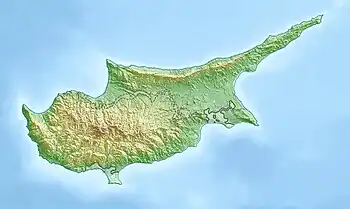Lempa | |
|---|---|
| Λέμπα (Greek) Lemba (Turkish) | |
 Lempa | |
| Coordinates: 34°48′47″N 32°24′20″E / 34.812968°N 32.40567°E | |
| Country | |
| District | Paphos District |
| Time zone | UTC+2 (EET) |
| • Summer (DST) | UTC+3 (EEST) |
Lempa (Greek: Λέμπα, Turkish: Lemba) is a village in Cyprus located approximately 4 km (2.5 mi) north of the town of Paphos. It is sometimes written as Lemba, which is also closer to the correct pronunciation. Neighbouring villages are Empa, Kissonerga and Chlorakas.
The village is located on top of an escarpment overlooking the Mediterranean Sea, and is set in one of the most fertile parts of Cyprus. The area produces citrus, olives, tomatoes and market-garden vegetables, and is one of the few parts of Europe where commercial banana production is possible.

The village is one of the most ancient in Cyprus, and since 1976 has been the site of ongoing archaeological excavations by the School of Archaeology at the University of Edinburgh. Lempa is believed to have been first settled in the Chalcolithic Period (c. 3800–2500 BC), and a number of cruciform female figurines, carved in stone, from this period have been found. In 1982, the Lemba Experimental Village was established as an archaeological project to recreate a Chalcolithic village and use it to undertake a number of historic activities, including use of building materials, pyrotechnology, pottery firing and prehistoric cooking methods. With the cooperation of the Cyprus Department of Antiquities, as well as the mayor and villagers of Lempa, the project has developed into an important visitor attraction as well as being for research into many aspects of experimental archaeology.
Lempa appears to have been occupied for most of the human history of Cyprus, and much later archaeological remains, including pottery fragments and coins from the Mediaeval period have been found there.
In 1958, after the intercommunal fights, the majority of Lempa villagers had to flee to Afania Village. And in 1959 the Lempa villagers has returned their houses right before the British Colonial Government agreed to establish Cyprus Republic.
In more recent times, Lempa was until 1963 a Turkish village, but following intercommunal violence on 2 January 1964 the Turkish population abandoned Lempa and settled in Paphos town. Following the Turkish invasion of Cyprus in 1974, the Turkish population moved to the north of Cyprus to primary Morphou, North Nicosia, Famagusta and Kyrenia and the village was fully abandoned except for a small number of Greek refugees. It was then resettled by displaced Greek Cypriots from the north.[2]
In 1981, Lempa became home to the Cyprus College of Art. Under the leadership of the Cypriot artist Stass Paraskos, the College renovated the former school building for use as artists' studios. The first artist to use the building was the British painter Euan Uglow.[3] Following the College a number of other artists have moved into the village which has since become an internationally known artists' colony.
As a consequence of the artists, archaeologists and art college in Lempa the Government of Cyprus announced in 2008 that the village was to receive major funding to become a 'Cultural Village'. This project would see improvements to the facilities of both the archaeological site and college, and new facilities for visitors to Lempa.[4] However this has proven controversial as to date the Cypriot government has not started on the development.[5]
References
- ↑ Vagnetti, Lucia (May–August 1991). "Stone Sculpture in Chalcolithic Cyprus". Bulletin of the American Schools of Oriental Research (282/283): 139–151. JSTOR 1357267.
- ↑ "LEMPA". PRIO Cyprus Displacement Center. Retrieved 28 March 2015.
- ↑ Michael Paraskos (ed). Stass Paraskos (Mitcham: Orage Press, 2009) 26f
- ↑ 'Cultural Villages' in Politis (Cyprus newspaper), 19 March 2008, p.62
- ↑ Michael Paraskos, 'Uncivil Service' in Cyprus Weekly (Cyprus newspaper), 11 February 2011, p.22
_1.jpg.webp) rechts
rechts_3.jpg.webp) miniatur
miniatur_2.jpg.webp) miniatur
miniatur
